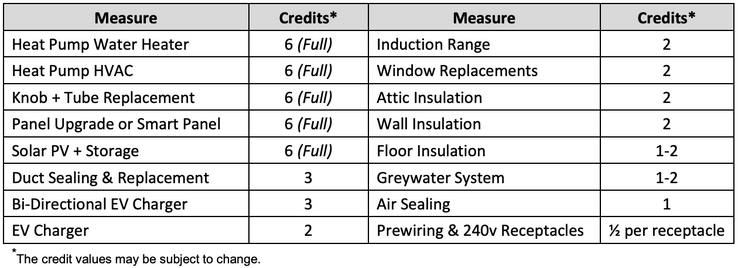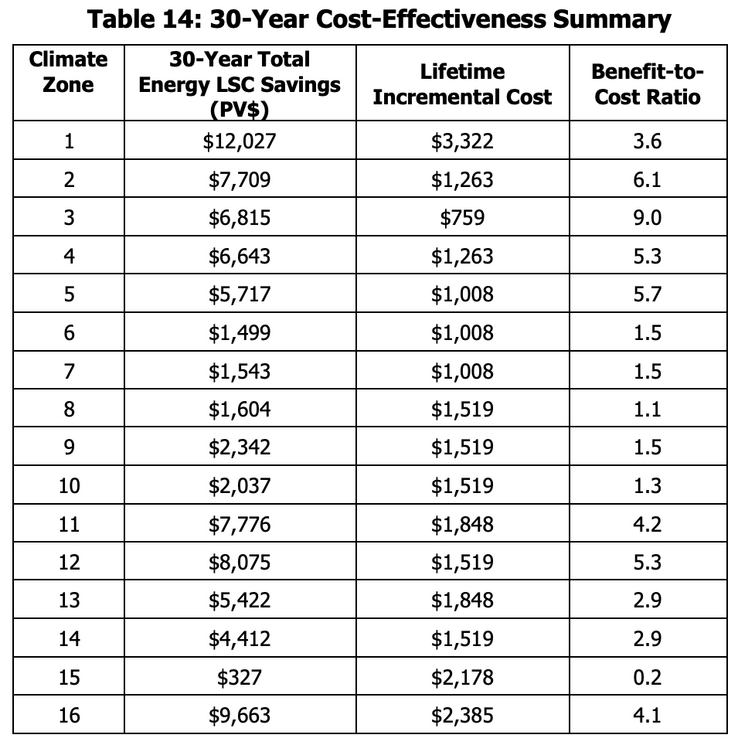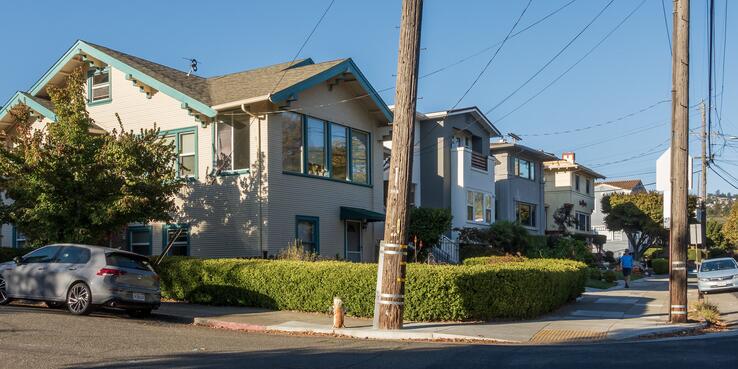SPUR and other advocates recently worked with the City of Berkeley to pass a measure that offers a smart pathway to move homes toward zero carbon emissions. The ordinance, an update to Berkeley’s Building Emissions Saving Ordinance (BESO), leverages a key juncture in a building's life cycle — its sale — to ensure upgrades are made without placing too great a financial burden on homeowners.
When owners place their homes on the market, they often install new appliances. When those new appliances use gas, they perpetuate a home’s health-harming and climate-warming emissions for a decade or more. The BESO amendment aims to avoid that lock-in by requiring electrification readiness and emissions reduction retrofits that will move homes off gas appliances. It does so through a novel enforcement mechanism: the buyer and seller negotiate a $5,000 deposit, held in an escrow account by the city, to pay for BESO compliance retrofits within a few years of the sale.
Regulatory Alignment
Building standards that incentivize timely electrification retrofits align well with the Bay Area Air District rule phasing out the sale of residential gas heating equipment (water heaters and furnaces). This rule, combined with state and local funding for building decarbonization, will rapidly transform the market for home appliances, shifting consumer preferences away from gas and toward nonpolluting equipment such as high-efficiency electric heat pumps.
The next critical step is adopting policies that ensure heat pumps are affordable for residents. Although heat pumps remain more expensive than gas counterparts, funding programs can close the affordability gap for many residents. As a result, many policymakers are pinning their hopes on rebates, full-service direct install programs, and financing for residents looking to “fuel switch” from gas to electric appliances.
Financial support is needed, but there’s another important dimension for public policymakers to consider: timing has a big impact on the affordability and cost-effectiveness of gas-to-electric retrofits. Retrofits are harder and more expensive to accomplish once equipment burns out and residents must arrange for an emergency replacement. But by planning for retrofits and taking steps over time to replace gas equipment with electric equipment, residents can save themselves money and hassle.
Time-of-Sale Approach
For decades, BESO has required time-of-sale upgrades to prepare for electrification and reduce emissions, but homeowners rarely complied because the ordinance lacked an enforcement mechanism. The amended ordinance solves this problem by requiring the seller and buyer to jointly set up an escrow account with $5,000 to pay for home upgrades. The buyer and the seller can negotiate how to distribute responsibility for paying into the account. The seller could either complete the retrofit before sale or pass the responsibility onto the buyer, who would then have up to three years to complete retrofits. If the upgrades are not made within three years of the sale, the money is forfeited to a city fund for low-income electrification. For-sale homes with electric heat pumps are not subject to BESO.
Berkeley’s BESO Time-of-Sale Ordinance Creates a Flexible Process for Making Home Efficiency Upgrades

Homeowners Have a Variety of Compliance Options
To meet the BESO time-of-sale requirements, the home buyer and/or seller must perform retrofits that achieve 6 points. Installation of a single heat pump water heater, for example, would fulfill the requirement on its own. Meeting the requirements through other improvements may require combining multiple retrofits (e.g. attic insulation, wall insulation and an EV charger).

The time-of-sale approach builds in a flexible process for home sellers and buyers to invest in upgrades during a time when home investments typically occur. If homeowners were forced to buy a heat pump when their furnace or water heater burned out, costs would be unexpected and out-of-pocket. Other cities in the Bay Area should consider replicating the approach to help prepare residents for the Bay Area’s zero-emission appliance rules coming, which start coming into effect in 2027.
Other Approaches to Timely Electrification
Two other approaches to timely electrification are air conditioner-to-heat pump requirements and major renovations ordinances.
Air Conditioner-to-Heat Pump Requirements
Most homes with air conditioning in California currently rely on two appliances for space conditioning needs —a gas furnace for heating and a central ducted AC system for cooling. When an AC system reaches the end of its useful life, residents commonly choose to replace it with another AC system that does not provide heating. This decision overlooks an opportunity to purchase a two-way heat pump device, which replaces both the furnace and air conditioner.
If homeowners replace their end-of-life AC system with another AC system, they may increase their home retrofit costs in the long run because in addition to the new AC system, they’ll likely buy a heat pump to comply with the Bay Area’s zero-emission appliance rules. The heat pump would turn the one-way AC system into a redundant appliance.
Even ignoring the existence of the Bay Area’s zero-emission rules, the economics of heat pumps look pretty good for homes with AC systems and gas furnaces. SPUR’s report on the affordability of clean heating equipment found that replacing a central ducted gas furnace and central AC with a centrally ducted heat pump could actually reduce upfront costs for homeowners who are able to access incentives available in the Bay Area. Other estimates suggest homeowners will pay a small premium to make the switch. But even so, they would enjoy immediate health benefits by improving their indoor air quality — benefits that may make that premium more than worth it.
Homeowners who do make the switch can also see bill savings. A recent RMI report found that typical variable-speed heat pumps are about 20% more efficient than the older air conditioners they replace, leading to similar savings on cooling costs. Moreover, heat pump users can benefit from electric-rate plans that reflect heat pumps’ lower cost to utilities, while low-income customers may see even greater savings through assistance programs offering larger electric discounts than gas discounts. A recent California Energy Commission cost-effectiveness report found that the 30-year lifecycle savings of replacing an air conditioner with a heat pump far outweigh the upfront cost in almost every climate zone.
Over a 30-Year Horizon, Heat Pump Energy Savings Outweigh Upfront Costs
Long-Term System Costs (LSC) take into account energy savings on utility bills from switching to a heat pump. These savings usually far outweigh any extra cost from buying a heat pump instead of other equipment.

To realize all the gains of AC-to-heat pump conversions, municipalities can pass “reach” codes that enact building performance standards that motivate residents to replace AC systems with heat pumps. The California Energy Commission recently added an AC-to-heat pump pathway to the voluntary CalGreen code. This pathway allows local governments to implement AC-to-heat pump ordinances wherever doing so would be cost-effective. Such ordinances offer jurisdictions a powerful tool to achieve building decarbonization goals and to ensure residents are making smart choices to prepare for zero-emission appliance rules.
Major Renovations Ordinances
San Francisco is considering a “major renovations” ordinance that would extend all-electric new construction requirements to buildings undergoing extensive retrofits—that is, replacement of mechanical equipment and significant architectural changes. The ordinance would take advantage of a life-cycle juncture when significant planning efforts and resources are marshalled to transform a building. Integrating decarbonization efforts into a major renovation is much like integrating them into new construction — and is a no-brainer in places where building standards have moved as much as 80 percent of new buildings to go all-electric, a figure based on data acquired through California Public Utilities Commission Decision 23-12-037.
Zero-emission rules, building codes, and other state and local policy measures will be moving buildings toward all-electric eventually. A major renovation of a building is the most cost-effective time to install heat pumps and electric equipment. The building is opened up, and the various building systems (mechanical, electrical, piping) that may need alterations to install electric equipment are already undergoing retrofits.
A Closing Window for Timely Building Electrification and Emissions Standards?
Cities may lose the ability to pass timely building electrification and emissions standards. Assembly Bill 306 (Rivas), currently winding its way through the California legislature, would suspend the ability of municipalities to implement new building standards over the next six years. The bill is designed to address the cost of building housing and to ensure that additional building standards are not applied to rebuilds of homes burned in Los Angeles earlier this year.
The bill, which acknowledges that California already has some of the most stringent building standards in the country, is well-intentioned. But it targets building standards not only for new homes but also standards for existing buildings, which are unlikely to impact housing construction costs. And innovative approaches to existing building standards, such as time-of-sale ordinances, AC-to-heat pump requirements, and major renovations ordinances, are critical tools for municipalities to reduce building emissions, improve health, and ensure more residents conduct efficient, flexible, and planned retrofits to comply with zero-emission appliance rules. AB 306 would also affect proposals for building performance standards that usually apply to commercial and multifamily buildings over a specified square footage (often ranging between 20,000 square feet and 50,000 square feet). Without amendments to AB 306, sustainability-minded cities will have to wait years to pass ordinances that fully realize the health, climate, and cost benefits of building electrification.
